by J.M. Iacchei
In a library’s conservation lab, tightly rolled photographs, brittle newspapers, weathered maps, and heavily soiled and torn architectural drawings are fairly common items to come across a conservator’s workbench. Every so often though, an item arrives for treatment that is not so typical. The collection of epigraphic squeezes (paper cast impressions from inscribed surfaces) recently brought to Cornell Library’s conservation lab falls into this category.
“SQUEEZES” & “SQUEEZING”
“Squeezing” is a method used in the field by archeologists to collect inscriptions from ancient monuments. The “squeeze” is made by laying dampened paper over an incised surface which is then beat with a flat brush and let to dry. Care to remove air bubbles and to capture each area of incision results in a highly accurate reverse relief of the inscription and a negative right-reading impression of the inscription.
THE VALUE OF A SQUEEZE
Squeezes are an incredibly valuable resource to scholars of epigraphy for a number of reasons:
1) Many monuments reside in distant locations; access often requires expensive and timely travel. Squeezes are lightweight and portable.
2) The squeeze allows for comparison to and revision of existing interpretations, as well as potential for fragmentary inscriptions to be pieced together. This is especially useful in reconstructing the topography of antiquity. The congruity of a text was often disrupted in times of conquest or political changes as it was common for monuments to be moved from their original locations and re-purposed for building materials.
3) Many monuments have become the casualties of time, man, and natural disasters. It is likely that they are in poorer condition today than they were at the time the squeeze was collected. Photographs are of value, yes, but, their accuracy depends heavily upon the light in which they were captured. A squeeze often provides the most complete, accurate and accessible copy of the text available to date.
THE J.R.S. STERRETT SQUEEZES
 These particular squeezes were collected as part of an archeological expedition to the Assyro-Babylonian orient organized by Cornell professor J.R.S. Sterrett in 1907. Following their use by Professor Sterrett in the early 20th century, these 200 or so items have been stored in an attic of the Goldwin Smith building in cardboard boxes. The roughly 90 that have been selected for treatment at this time were collected from the Res Gestae in Ankara of the Roman Emperor Augustus. Inscribed in both Latin and Greek, they contain a text central to the study of Roman history.
These particular squeezes were collected as part of an archeological expedition to the Assyro-Babylonian orient organized by Cornell professor J.R.S. Sterrett in 1907. Following their use by Professor Sterrett in the early 20th century, these 200 or so items have been stored in an attic of the Goldwin Smith building in cardboard boxes. The roughly 90 that have been selected for treatment at this time were collected from the Res Gestae in Ankara of the Roman Emperor Augustus. Inscribed in both Latin and Greek, they contain a text central to the study of Roman history.
CONSERVATION TREATMENT
The squeezes arrived to the lab heavily coated with surface soil – dust, and dirt; maybe even a little inactive mold. Due to the topographic nature of the squeezes the surface soil is heavily ingrained, especially in the curves and angles of the raised impressions. The squeezes are composed of multiple layers of paper which have begun to delaminate and have become creased with folds from previous storage and handling.
The objective of conservation treatment is to: 1) clean and stabilize the squeezes prior to scanning and digitization and 2) provide a permanent storage solution taking into consideration size, quantity, topographic nature, and spatial limitations.
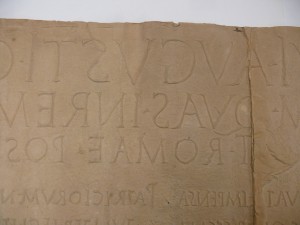
During Treatment, cleaning: The right half of this image has been vacuumed, the left has been both vacuumed sponge cleaned
Cleaning: The squeezes were vacuumed with a NILFISK Hepa vacuum, and cleaned once with absorene sponge erasers and again with latex free cosmetic sponges. Each cleaning method contributed to reducing the buildup of dirt and dust on the surface.
Stabilization: Local humidification was used to reduce folds and creases that were not part of the inherent nature of the items topography. Areas that had begun to delaminate were generally left alone unless they were at risk of becoming torn or presented potential for loss. In these instances, Japanese tissue and/or wheat starch paste was used to stabilize the area.
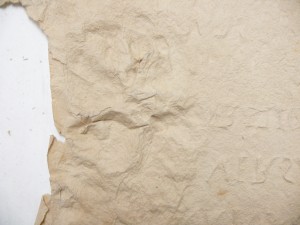
The study of epigraphy takes into account not only the incised impressions, but also the surface of the monument on which it is inscribed. The squeezes capture these characteristics showing cracks and dents, as well as areas where the stone was not carved or perhaps smoothed over for correction or reuse. They lend a great deal of information to the epigraphist looking to piece together the story of earlier times.
This project is part of a larger initiative funded by the Grants Program for Digital Collection in Arts and Sciences to preserve and promote accessibility for research, study, and dissemination. The scope extends beyond the lab and has called upon the collaboration of conservators, curators, faculty, and imaging specialists. Once cleaned and stabilized, the squeezes will be digitally imaged using different lighting at different angles. These images will then be given to a group at Florida State University where algorithms will be applied to render 3-D reconstructions that will in turn be studied by graduate students of the Cornell University’s Classics department.
Many thanks to Professors Eric Rebillard and Ben Anderson for their insights into the significance of these items, and to Rhea Garen who will be capturing the images. It is the collaborative efforts that make projects such as this one possible.
More to come. Epigraphic Squeezes: Part II and III. Fiber Analysis and Exploration in Squeeze Making are in progress.
_____________________________________________________
References:
McLean, B. H. An introduction to Greek Epigraphy of the Hellenistic and Roman Periods from Alexander the Great down to the Reign if Constantine (323 B.C.-A.D. 337). Ann Arbor: The University of Michigan Press, 2002.
Olmstead, A.T., B.B. Charter, and J.E. Wrench. The Cornell Expedition to Asia Minor and the Assyro-Babylonian Orient, Travels and Studies in the Nearer East, Volume 1 Part II: Hittite Inscriptions. Ithaca, NY, 1911.

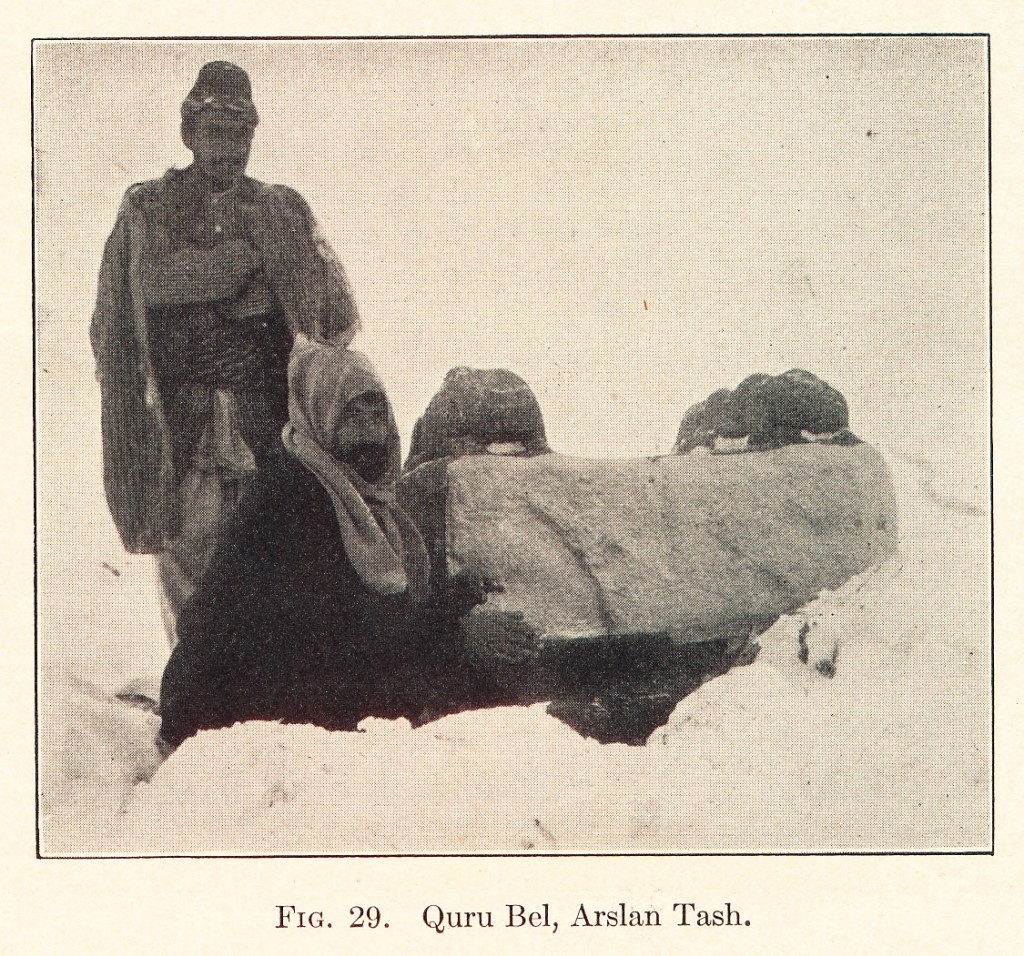
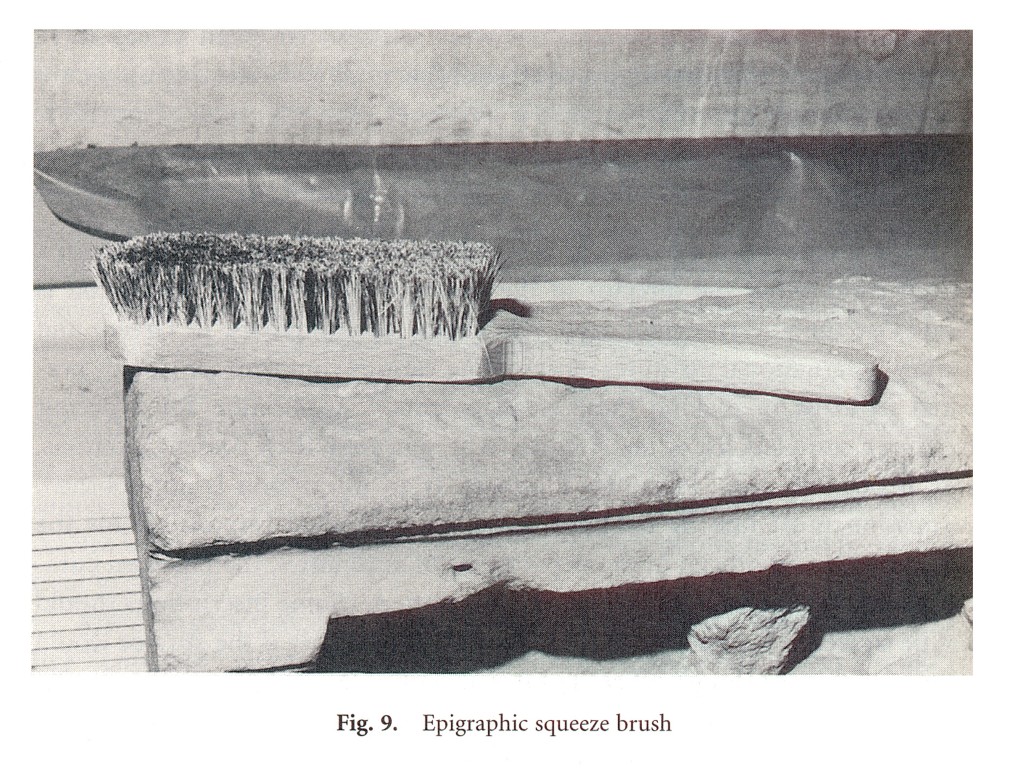
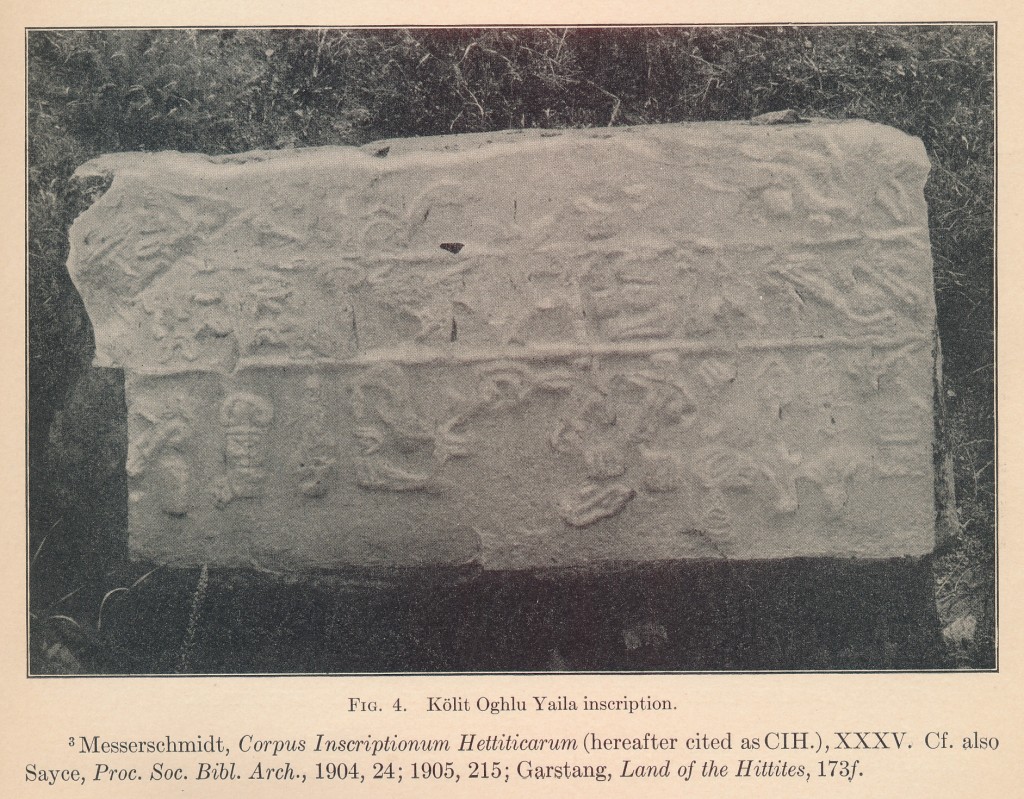
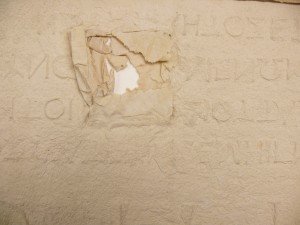
Dear Sir / Madam
I would kindly ask you to inform me where could I purchase a squeeze brush.
Thank you in advance
Nora Okka
Dipl. Architect Engineer – National Technical University of Athens
Master in Digital Arts – Athens School of Fine Arts
MAS in Scenography – Zurich University of the Arts
PhD Candidate in Architecture Curating – Vienna University
DENOCRATOUS 18A
106 75 ATHENS GR
T +30 210 72 17 775
M +30 6976 455 313